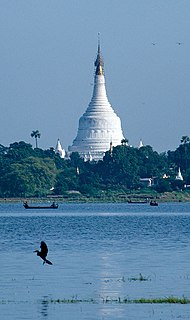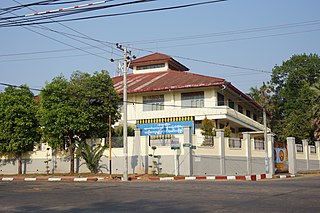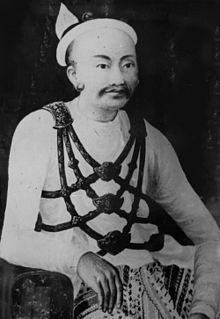
Myanmar is an emerging economy with a nominal GDP of $69.322 billion in 2017 and an estimated purchasing power adjusted GDP of $327.629 billion billion in 2017 according to World Bank. For 2018 estimate, the country's per capita will be $6,509 in PPP per capita and $1,490 in nominal per capita.
Saya Tin was a Burmese composer. He was one of three well known pre-war composers with the name Saya Tin. The others were Nandawshae Saya Tin and Thahaya Saya Tin. He is best known for composing "Kaba Ma Kyei", the national anthem of Burma (Myanmar).

The kyat is the currency of Myanmar (Burma). It is often abbreviated as "K" or "Ks" (plural), which is placed before or after the numerical value, depending on author preference.

Mogok is a city in the Pyin Oo Lwin District of the Mandalay Region of Myanmar, located 200 km north of Mandalay and 148 km north-east of Shwebo. Mogok was in Shan State and after British, the town was put in Mandalay Region along with Pyin Oo Lwin.

Amarapura is a former capital of Myanmar, and now a township of Mandalay city. Amarapura is bounded by the Irrawaddy river in the west, Chanmyathazi Township in the north, and the ancient capital site of Ava (Inwa) in the south. It was the capital of Myanmar twice during the Konbaung period before finally being supplanted by Mandalay 11 km north in 1859. It is historically referred to as Taungmyo in relation to Mandalay. Amarapura today is part of Mandalay, as a result of urban sprawl. The township is known today for its traditional silk and cotton weaving, and bronze casting. It is a popular tourist day-trip destination from Mandalay.

Inwa or Ava, located in Mandalay Region, Burma (Myanmar), is an ancient imperial capital of successive Burmese kingdoms from the 14th to 19th centuries. Throughout history, it was sacked and rebuilt numerous times. The capital city was finally abandoned after it was completely destroyed by a series of major earthquakes in March 1839. Though only a few traces of its former grandeur remain today, the former capital is a popular day-trip tourist destination from Mandalay.

Mandalay Region is an administrative division of Myanmar. It is located in the center of the country, bordering Sagaing Region and Magway Region to the west, Shan State to the east, and Bago Region and Kayin State to the south. The regional capital is Mandalay. In the south of the division lies the national capital of Nay Pyi Taw. The division consists of seven districts, which are subdivided into 30 townships and 2,320 wards and village-tracts.
The rupee was the currency of Burma between 1852 and 1952, except for the years 1943–1945.
Panthays form a group of Chinese Muslims in Burma. Some people refer to Panthays as the oldest group of Chinese Muslims in Burma. However, because of intermixing and cultural diffusion the Panthays are not as distinct a group as they once were.
Articles related to Myanmar include:

The Internet in Myanmar has been available since 2000 when the first Internet connections were established. Beginning in September 2011, the historically pervasive levels of Internet censorship in Burma were significantly reduced. Prior to September 2011 the military government worked aggressively to limit and control Internet access through software-based censorship, infrastructure and technical constraints, and laws and regulations with large fines and lengthy prison sentences for violators. In 2015, the internet users significantly increased to 12.6% with the introduction of faster mobile 3G internet by transnational telecommunication companies, Telenor Myanmar and Ooredoo Myanmar, and later joined by national Myanmar Post and Telecommunications (MPT). While the internet situation in Myanmar has constantly been evolving since its introduction in 2010 and reduction of censorship in 2011, laws such as the 2013 Telecommunications Law continue to restrict citizens from total freedom online. Despite restrictions, internet penetration continues to grow across the country.

The Mon State Cultural Museum is a museum located at No 50, Htawai Bridge Road & Baho Road, in Mawlamyine, Mon State in Burma. It displays musical instruments, bronzeware, silverware, coins and figurines of the Mon people, cabinets for keeping Buddhist artefacts, and divans used by the daughter of King. .

The National Theatre of Yangon, located in Yangon, is a national theatre of Myanmar. The theatre is used for cultural exchange programs with foreign countries, for departmental workshops, religious ceremonies, prize giving ceremonies, performing arts competitions, and for musical stage shows.

The Third Anglo-Burmese War, also known as the Third Burma War, was a conflict that took place during 7–29 November 1885, with sporadic resistance and insurgency continuing into 1887. It was the final of three wars fought in the 19th century between the Burmese and the British. The war saw the loss of sovereignty of an independent Burma under the Konbaung dynasty, whose rule had already been reduced to the territory known as Upper Burma, the region of Lower Burma having been annexed by the British in 1853, as a result of the Second Anglo-Burmese War.

Burmese Gurkhas are a group of Nepali language speaking Burmese people of Gurkha ethnic group living in Myanmar. While the Gurkhas have lived in Burma for many centuries, it was during the British rule in Burma that the majority of the Gurkha migrated from Nepal.

Yenatha or Yentha is a village in Madaya Township, Pyin Oo Lwin District, in the Mandalay Region of central Burma. It is located 7 miles northeast of Madaya, connected by the National Highway 31. The Japanese were reported to have "put up pockets of resistance" at Yenatha during World War II. The Madaya River flows nearby to the south and joins the Irrawaddy River as well as the Yenatha Canal as part of the Mandalay Canal network. The Yenatha Irrigation Scheme has been funded by the Asian Development Bank, who recognizes the importance and potential of agriculture and fisheries in the area. The canal involves a pump irrigation scheme and cost some 9,900,000 kyat to build. A Leprosy hospital lies to the south of Yenatha.

The Yangon–Mandalay Expressway is an expressway in Myanmar (Burma) that connects the country's largest city Yangon and second largest city Mandalay. Opened in December 2010, the 587 km (365 mi) expressway has reduced the travel time between Yangon and Mandalay to 7 hours from 13 hours by train and from 16 hours by the old highway. The highway, which does not meet international design, construction and safety standards has seen a spate of accidents since its opening.

Shwekyimyint Pagoda is a notable pagoda in Mandalay, Burma, located on 24th Street, between 82nd and 83rd Streets. It was built in 1167 by Min Shin Saw, a prince from Pagan, who had come to the shores of the Aungbinle lake to cultivate rice. In the early 1900s, in one of its chapels, 40 images of Buddha found in the Mandalay Palace at the time of the British occupation in 1885 are kept for safe custody. A pagoda was built in 1852 over the older one. It is known for the Shweilnbin, an image of Gautama Buddha that was originally placed in the a pagoda built in Pagan by King Narapatisithu and consequently moved to other royal capitals.

Jin Taw Yan, is a Mahayana Buddhist temple located on Strand Road in Mandalay, Myanmar (Burma). The temple was officially opened on 18 February 2014, and faces the Irrawaddy River. Construction began in 2009, and cost approximately 4.5 billion kyats, with 20% of funds coming from the Capital Diamond Star Group. The temple is reputed to be Myanmar's largest Chinese temple.

















